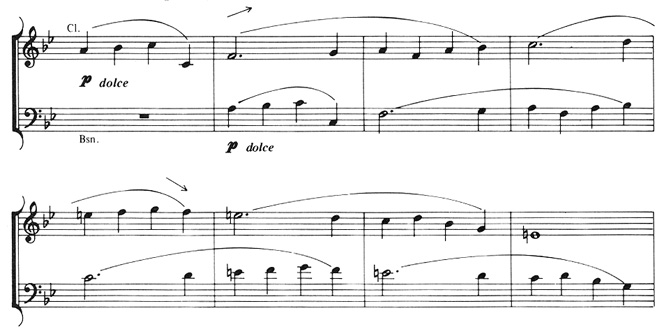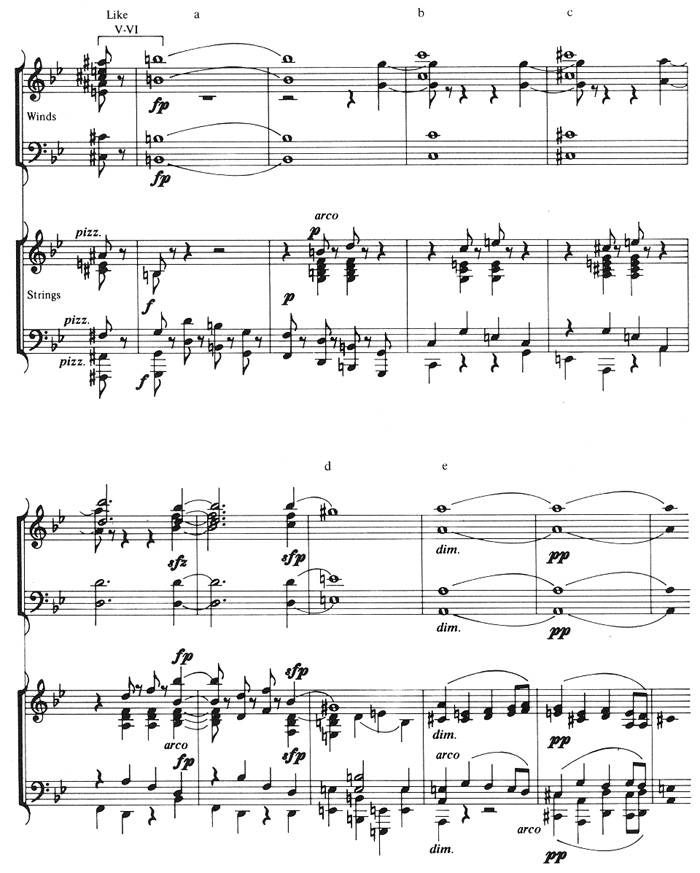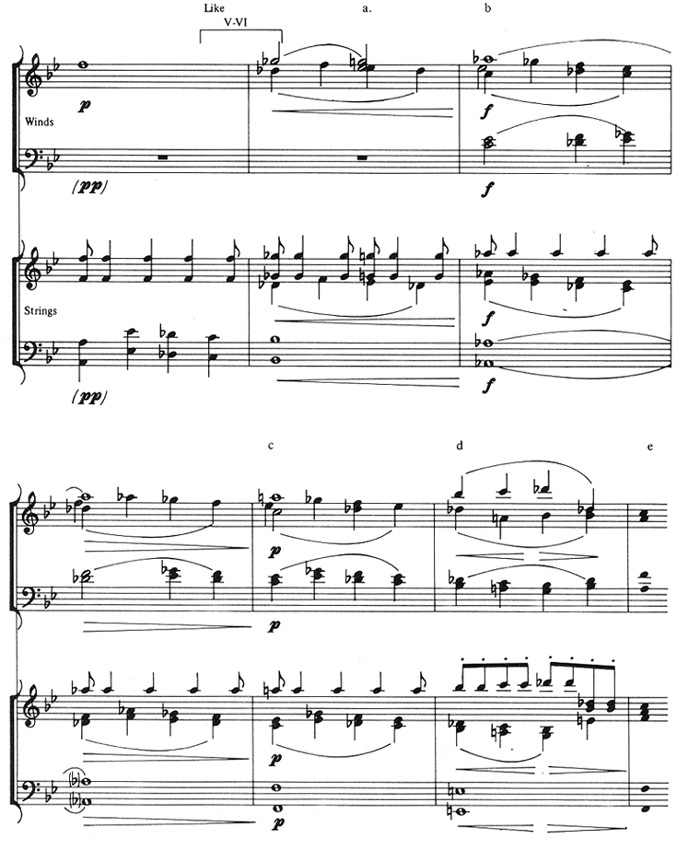Antony Hopkins' recent popular introduction to Beethoven's symphonies focuses for a page or two on a short passage in the Fourth Symphony—measures 121-32 of the first movement.1 Hopkins shows how the passage is like a comparable one in the Fifth Symphony (first movement, measures 196ff.); he also explains its kinship to the measures that immediately preceded it in the Fourth. By such a commentary Hopkins helps to school the amateur to recognize musical recurrences appearing either within a work or outside it.
Can the properties and functions of these very different kinds of recurrences be gauged on a common scale? Analysts from the field of music theory generally rest content in demonstrating how repetition and variation operate within individual compositions; they leave it to the music historians to deal with the shared elements that thread through one or another repertory. The two approaches reach quite separate goals, though restatement of musical materials serves as an object of study for both. Perhaps by taking the standpoint of the listener rather than the vantage of scholars one achieves a more encompassing perspective. The listener can bring closer together what the experts have divided. That is, when a certain piece is heard, the hearer's memory is an agent capable of acknowledging recurrences from near and far and of permitting them all to be part of the same musical experience.
Listening cannot be done on paper, but with imagination invoked—and with a cue from Hopkins acted on—let "a certain piece" be Beethoven's Fourth Symphony. Three or four instances of varied restatement within the work can be compared for the purpose of clarifying their distinctive roles. Beyond this lies the riskier question of how the symphony may be said to re-create moments from other works. Again a few examples can be brought forward. Both sets of examples treat mostly melody, and cases of exact repetition have been excluded.
Example 1 sets out first the main theme of the Fourth Symphony's first movement (a) and then its "closing theme" (b), in which the zigzag arpeggiation of the main theme also resides.
Ex. 1.
a. Beethoven, Symphony No. 4, 1st movement, measures 43-45

b. Measures 177-81

The end of any sonata exposition is an area of stability, and in the Fourth Symphony this stability gains strength from the reappearance of a well established element of the first theme, freshly expressed in augmentation and with syncopation (a feature borrowed from the bridge)2 but otherwise barely disguised. Such a recurrence, wherever it arises in a sonata-allegro movement, makes for a feeling of constancy. The more allied the tonal functions of the congruent passages the greater the tendency to fixedness.
Zigzag arpeggiation appears frequently in the Fourth Symphony's later movements and acts as an essential element of their style.3 At two points where new themes might be expected to enter and by their entrance to demarcate sections of the form, the telltale arpeggiation in fresh garb reasserts itself. Example 2a shows the cello melody that rests on the dominant plateau within the second movement, an Adagio in E-flat.
Ex. 2.
a. Beethoven, Symphony No. 4, 2nd movement, measure 34

b. 3rd movement, measures 1-4

c.

Since B-flat is the key of the symphony as a whole, the recollection of the first movement is all the more precise. This reference, pointing as it does beyond the frame of the Adagio, transcends the division between movements, though without imperiling the integrity of the slow movement's design. Example 2b shows the melody that begins the Scherzo. Here in a movement whose tonic is B-flat a purely leaping form of zigzag arpeggiation appears. At a place in the work where a listener in any event expects a return to the animation of the first Allegro, the kinship of Examples la and 2b heightens the sense of a return. However, the extent to which the Scherzo theme also represents novelty and progress can be appreciated by a comparison with a counterfactual example. Were the Scherzo to have a main theme like that suggested in Example 2c, some degree of structural subordination would threaten the slow movement, now environed on both sides by much the same music.
Whenever two very similar passages occur in successive movements, there exists the possibility that the later one will detach itself from its immediate surroundings. Repeating exactly or nearly exactly an earlier portion of a work—that is, presenting a quotation—can disturb the normal progress of a movement. The Fourth Symphony provides no instance of such a disturbance. But what of the reverse situation? An irregular or even inexplicable event may resurface in a later movement and there be quite at peace in its new circumstances. In the Fourth Symphony the slightly odd intervention of the horns at the close of the third movement (Ex. 3a) has this prospective function. The overemphatic move from tonic to supertonic at this point becomes absorbed into the Finale's main theme, in which it makes two prominent appearances (Ex. 3b). Both the Scherzo cadence and the Finale theme each in its own way look back to the opening of the Trio (Ex. 3c).4
Ex. 3.
a. Beethoven, Symphony No. 4, 3rd movement, measures 21-24

b. 4th movement, measures 1-4

c. 3rd movement, measures 91-94

The Trio has been a section wherein an initial stepwise rise proceeds to work itself out in a customary way. The abrupt close of the whole dance movement denies the horn entry a parallel fulfillment, but the opening of the Finale supplies a follow-through. Again, as with some of the appearances of the zigzag arpeggiation, a recurrence serves a structural purpose that overshoots the formulation of an individual movement.
In listening to the Fourth Symphony, a well versed Beethovenian might be struck by resemblances to some earlier works by its composer.5 For instance, the main theme of the symphony's first movement, with its zigzag layout of the B-flat triad, sounds somewhat like the openings of Beethoven's Piano Sonata Opus 22 and his String Quartet Opus 18, No. 6.6 An awareness of this can set the stage for further perceptions of the works' similarities. One part of the second-theme group in the symphonic first movement re-creates aspects of the "closing theme" in the first movement of the sonata (Exx. 4a and b). The stepwise rise of the line starting from the tonic, the intermixture of the rhythmic figures shown in Example 4c,7 and the comparatively slow harmonic progress from I to V are the most important of these aspects. In the development section the sonata enhances the likeness by fragmentary imitation at points where the "closing theme" reenters.
Ex. 4
a. Beethoven, Symphony No. 4, 1st movement, measures 141-48

b. Beethoven, Piano Sonata Op. 22, 1st movement (Allegro con brio), measures 62-66

c. Symphony No. 4

Earlier, in its second-theme group, the sonata had presented a sequence comprising a figure of falling thirds and a threefold repetition of it, rising by step (Ex. 5a). No close parallel to this music is found in the symphony—not even the rising sequential passage shown in Example 5b, the one of which Hopkins speaks. But a keen recognition that the symphony is in other respects like the sonata helps to reveal a latent similarity here. By taking the chain of falling thirds and rising sixths to be a suppressed component of the symphony's sequence, one can perceive a reworking of a motive heard earlier in the piece. That is, a memory of a passage from Opus 22 is capable of showing how a rather obscure moment in the Fourth Symphony connects with the main theme (see Ex. 5c).
Ex. 5.
a. Beethoven, Piano Sonata Op. 22, 1st movement, measures 30-34

b. Beethoven, Symphony No. 4, 1st movement, measures 121-26

c.

Sometimes the force of precedent operates in movements having quite different tempos and expressive characters. The Minuet of Opus 22 sets out a pair of phrases that neatly match the opening of the Fourth Symphony's slow movement (Exx. 6a and b).8 If the sudden appearance in the sonata of the subsequent D-major chord functioning as an "applied dominant" has imprinted itself on the mind, then in the symphony the somewhat postponed appearance of the same major mediant (color V7) will come with an extra sense of rightness. In the Adagio theme the fourth and fifth measures, using a "misapplied dominant" whose root is again the mediant, provide a local model for what is to come in measure 20; the piano sonata provides an external one.
The eight measures that begin the dance movement of the quartet Opus 18, No. 6 (Ex. 6c) are built on much the same foundation as the openings of the symphony's Adagio and the sonata's Minuetto.
Ex. 6
a. Beethoven, Piano Sonata Op. 22, 3rd movement (Minuetto), measures 1-8

b. Beethoven, Symphony No. 4, 2nd movement (Adagio), measures 2-9

c. Beethoven, String Quartet Op. 18, No. 6, 3rd movement (Scherzo. Allegro), measures 1-8

And in the quartet, too, the major mediant soon appears. In at least two respects the opening of this Scherzo resembles the symphonic movement more than does the Opus 22 Minuet: (1) the melodies from both the symphony and the quartet traverse a descending sixth in conjunct moves at the outset and later close (in measure 4) at a fourth below the initial note, and (2) in both, the harmonies that begin the consequent phrase (measures 4ff.) give play to the supertonic chord for a time before the dominant is attained. Yet despite this it is hard to hear the Scherzo as lying behind the opening theme of the symphony's slow movement, though the Minuet of the piano sonata strongly resembles both.
A remembered passage can most readily contribute to one's grasp of a later work when a common context allies the present music to that which is recalled. So the first theme of the Fourth Symphony's slow movement easily relates to a few measures in the E-flat Adagio of the sonata Opus 22 (Ex. 7).
Ex. 7. Beethoven, Piano Sonata Op. 22, 2nd movement (Adagio con molto expressione), measures 65-67

The placing, function, and character of the movements foster the relationship. On the other hand, identity between two passages in different works without a larger field of relevance makes an almost inert connection. No consequences for the listener flow from even the closest resemblance found in otherwise dissimilar pieces. For example, a hearing of the Fourth Symphony gains hardly anything from the fact that a cadential formula in its Finale, measures 88-94, occurs also in Rocco's song from Fidelio, Act I ("Hat man nicht auch Gold beineben," measures 36-39).9
When context is given its due, the impress of earlier Viennese symphonies makes itself felt. Among Haydn's twelve "London" symphonies the two in B-flat, Nos. 98 and 102, have slow introductions that much resemble the opening section of Beethoven's Fourth Symphony. Symphony No. 102 and the work by Beethoven make the same opening gesture—just a soft sustained B-flat covering four octaves in winds and strings. In both, at a point that marks roughly a quarter of the time spent on the introduction, the opening sonority reappears with the same instrumentation as before. This likeness in a sense establishes the possibility of later cognate passages, which do in fact ensue. For instance, the quotations given as Examples 8a and b, apart from more general similarities, parallel each other in the harmonic sphere. Preceded by a "deceptive cadence," the succession of chords marked a through e is present in both examples. In the Fourth Symphony the chords appear at a major third higher than in Haydn's Symphony No. 102.
Ex. 8.
a. Haydn, Symphony No. 102, 1st movement, measures 12-17
b. Beethoven, Symphony No. 4, 1st movement, measures 24-34

These introductions are allied to that which opens Haydn's Symphony No. 98. All three, at one point or another, dwell on G-flat, the lowered submediant, but the prominence of this note is only one feature that links measures 1-4 of Symphony No. 98 with the opening of the work by Beethoven (Exx. 9a and b). (A use of zigzag arpeggiation shows up in the Haydn example. Does it hint at the main theme of the Fourth Symphony's Allegro?)
Ex. 9.
a. Haydn, Symphony No. 98, opening
b. Beethoven, Symphony No. 4, opening

Examples 1 through 9 above have moved farther and farther away from a consideration of the Fourth Symphony's structural components as these are usually defined. The listener's experience of the symphony goes beyond these and includes his memories not only of what happens earlier in a movement (Ex. 1) and earlier in the work (Exx. 2 and 3), but also of what happens in earlier works by Beethoven (Exx. 4, 5, 6 and 7) and in other earlier works (Exx. 8 and 9). Now in order to hold back a limitless horde of external references, a barrier needs to be thrown up between reminiscences that belong to the work and those that belong purely to the private world of the listener's associations. A common-sense categorization suggests itself. As a given work creates associations with others in the listener's mind, the associations that should be warranted are those that join the work with earlier pieces by the same composer and with pieces he probably heard and studied. If this principle is accepted, then in listening to a composition one can attend at once to the internal structure of the work and to a putative "mind of the composer" behind the work. The integrity of a composition, the strength of the network of relationships that knit it together, will not be weakened by legitimating another set of memories and anticipations. An awareness of what the composer knows and has done can have a place in the listener's knowledge of what he is doing.
1Antony Hopkins, The Nine Symphonies of Beethoven (London: Heinemann; Seattle: University of Washington Press, 1981), pp. 106-7.
2See Carl Dahlhaus, Ludwig van Beethoven. IV. Symphonie B-Dur, Meisterwerke der Musik: Werkmonographien zur Musikgeschichte, No. 20 (Munich: Wilhelm Fink, 1979), p. 13.
3Other means for fostering unity between the movements of the Fourth Symphony are canvassed by Ludwig Misch in his Die Faktoren der Einheit in der Mehrsätzigkeit der Werke Beethovens: Versuch einer Theorie der Einheit des Werkstils, Veröffentlichungen des Beethovenhauses in Bonn, new series, 4th category (Schriften zur Beethovenforschung), No. 3 (Munich and Duisburg: G. Henle, 1958), pp. 54-72.
4See Ibid., p. 67, concerning the themes of the Trio and the Finale. With no reference to the third movement, Leonard B. Meyer has called the AB-flatC in measures 3-4 of the Finale a "coda figure" (Meyer, Explaining Music: Essays and Explorations [Berkeley: University of California Press, 1973], p. 223).
5A variety of Beethoven precedents for passages in the Fourth Symphony are of course cited in such descriptive analyses as are given in Hopkins, pp. 99-124, in Dahlhaus, pp. 7-28, and in Karl Nef, Die neun Sinfonien Beethovens (Leipzig: Breitkopf und Härtel, 1928), pp. 107-33.
6Joseph Kerman in his book The Beethoven Quartets (New York: Alfred A. Knopf, 1967), pp. 71-74, describes several of the similarities that link the first movements of Opus 22 and Opus 18, No. 6, both of which are also in B-flat.
7The connection of these two figures is important elsewhere in the Fourth Symphony, as is made clear in Misch, pp. 64-66.
8As Dahlhaus, p. 18, points out, in the symphonic theme five notes of the inner voice (Ex. 6b, D through A) later appear in the melody in diminution (measure 3, A through E-natural). The sonata melody (Ex. 6a) follows the path of the symphonic inner voice in measures 1-3.
9But the main theme of the symphony's first movement should be compared with the song, measures 41-44. Misch, p. 66, finds an operative precedent for the Finale's cadential formula in the Fourth Symphony's first movement, measures 139-41.




